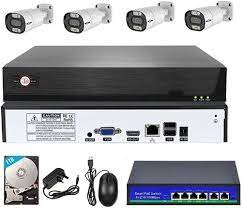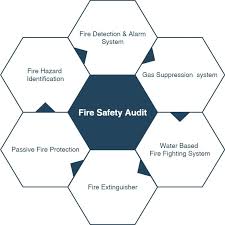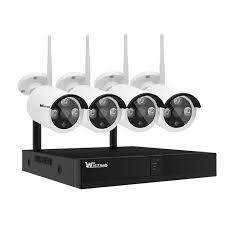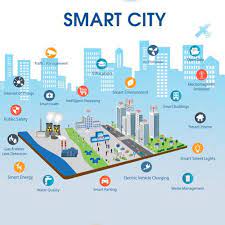NVR Camera: The Future of Video Surveillance
In today’s digital age, video surveillance has become an essential aspect of ensuring security and peace of mind. With advancements in technology, traditional analog surveillance systems are gradually being replaced by more advanced and efficient solutions. One such innovation that has gained significant popularity is the Network Video Recorder (NVR) camera.
So, what exactly is an NVR camera? Unlike its predecessor, the Digital Video Recorder (DVR), an NVR camera does not require a direct connection to a recording device. Instead, it uses IP (Internet Protocol) technology to transmit and store video footage directly onto a network or cloud-based storage system.
The benefits of NVR cameras are numerous. Firstly, their high-resolution capabilities provide crystal-clear image quality, allowing for accurate identification and monitoring. Whether it’s for home security or commercial purposes, the ability to capture sharp footage is crucial in ensuring effective surveillance.
Secondly, NVR cameras offer flexible installation options. With a wireless connection option available, these cameras can be placed virtually anywhere within the Wi-Fi range. This eliminates the need for extensive wiring installations and allows for a more discreet setup.
Furthermore, NVR cameras come equipped with advanced features that enhance their functionality and usability. Many models offer motion detection capabilities that trigger automatic recording when movement is detected within the camera’s field of view. This not only saves storage space but also enables easy retrieval of specific incidents from the recorded footage.
Another noteworthy feature is remote access. With an NVR camera system connected to the internet, users can conveniently monitor their premises from anywhere using a smartphone or computer. This accessibility ensures round-the-clock surveillance and provides real-time alerts in case of any suspicious activity.
Moreover, NVR cameras often integrate seamlessly with other security systems such as access control systems or alarm systems. This integration creates a comprehensive security solution that can be managed from a single platform, enhancing overall efficiency and convenience.
One concern that arises with any network-connected device is cybersecurity. However, reputable NVR camera manufacturers prioritize security measures, ensuring encrypted data transmission and secure access protocols. It is crucial for users to choose trusted brands and regularly update firmware to maintain the highest level of security.
In conclusion, NVR cameras have revolutionized video surveillance systems, offering superior image quality, flexible installation options, advanced features, and remote accessibility. With their ability to seamlessly integrate with other security systems and their focus on cybersecurity, NVR cameras are undoubtedly the future of video surveillance. Whether it’s for residential or commercial use, investing in an NVR camera system provides a reliable and efficient solution for protecting your property and loved ones.
7 Frequently Asked Questions About NVR Cameras: Everything You Need to Know
- What is an NVR camera?
- How do I set up an NVR camera system?
- What are the benefits of using an NVR camera?
- What types of cameras can be used with an NVR system?
- How do I connect my NVR camera to my network?
- How secure is an NVR surveillance system?
- What features should I look for in a quality NVR camera system?
What is an NVR camera?
An NVR camera, also known as a Network Video Recorder camera, is a type of surveillance camera that uses IP (Internet Protocol) technology to transmit and store video footage. Unlike traditional analog cameras that require a direct connection to a recording device, NVR cameras can directly connect to a network or cloud-based storage system.
NVR cameras capture high-resolution video footage and transmit it over an IP network. This allows for remote viewing and management of the camera’s feed from anywhere with an internet connection. The recorded footage is stored digitally on the NVR or in the cloud, providing easy access and retrieval when needed.
These cameras offer several advantages over analog systems. They provide superior image quality, often in high-definition or even ultra-high-definition resolutions, resulting in clearer and more detailed video recordings. NVR cameras also offer flexible installation options, including wireless connectivity, which eliminates the need for extensive wiring installations.
Many NVR cameras come equipped with advanced features such as motion detection, which triggers automatic recording when movement is detected within the camera’s field of view. This saves storage space and allows for easy retrieval of specific incidents from the recorded footage.
Remote access is another key feature of NVR cameras. Users can monitor their premises in real-time using a smartphone, tablet, or computer through dedicated software or mobile apps. This accessibility enables round-the-clock surveillance and provides instant alerts in case of any suspicious activity.
NVR cameras can also integrate with other security systems such as access control systems or alarm systems. This integration creates a comprehensive security solution that can be managed from a single platform, enhancing overall efficiency and convenience.
It’s important to note that cybersecurity is crucial when using NVR cameras connected to networks. Reputable manufacturers prioritize security measures like encrypted data transmission and secure access protocols to protect against unauthorized access.
In summary, an NVR camera is a modern surveillance solution that utilizes IP technology to transmit and store high-resolution video footage digitally. With their advanced features, flexible installation options, remote access capabilities, and integration with other security systems, NVR cameras offer enhanced security and convenience for both residential and commercial applications.
How do I set up an NVR camera system?
Setting up an NVR camera system may seem daunting at first, but with the right guidance, it can be a straightforward process. Here are the general steps to help you get started:
- Plan and Design: Determine the areas you want to monitor and identify the number of cameras required. Consider factors such as entry points, blind spots, and specific surveillance needs. Create a rough layout of where each camera will be installed.
- Choose the Right NVR System: Select an NVR system that suits your requirements in terms of camera compatibility, storage capacity, and desired features. Ensure it supports the number and type of cameras you intend to install.
- Install Cameras: Follow the manufacturer’s instructions to install the cameras in their designated locations. Make sure they are securely mounted and positioned to capture the desired field of view.
- Connect Cameras to NVR: Connect each camera to the NVR using Ethernet cables or via a wireless connection if supported. Ensure proper cable management for a neat installation.
- Power Up: Connect power adapters or PoE (Power over Ethernet) switches to provide power supply to both the cameras and NVR unit.
- Network Configuration: Configure network settings on your NVR system, such as assigning IP addresses or enabling DHCP (Dynamic Host Configuration Protocol) for automatic IP assignment.
- Accessing the System: Connect your NVR system to your network router using an Ethernet cable or utilize Wi-Fi connectivity if available on your unit. This step enables remote access and allows you to view live footage or recorded videos from anywhere using a computer or smartphone.
- Set up Recording Parameters: Access your NVR’s web interface through a computer browser or dedicated software provided by the manufacturer. Configure recording parameters such as motion detection sensitivity, schedule recording times, and storage allocation for each camera.
- Test and Fine-tune: Verify that all cameras are functioning properly by viewing live footage on your computer or smartphone. Adjust camera angles, focus, and settings if necessary.
- Additional Features: Explore additional features offered by your NVR system, such as mobile app integration, email alerts for motion detection, or remote playback options. Customize these settings according to your preferences.
Remember to consult the user manual provided with your NVR system for specific instructions and troubleshooting tips. If you encounter any difficulties during the setup process, don’t hesitate to reach out to the manufacturer’s customer support for assistance.
What are the benefits of using an NVR camera?
Using an NVR camera offers several benefits that make it a preferred choice for video surveillance. Here are some key advantages:
- High Image Quality: NVR cameras provide high-resolution video footage, allowing for clear and detailed images. This ensures accurate identification of people, objects, and events, enhancing the effectiveness of surveillance.
- Flexible Installation: With wireless connectivity options, NVR cameras can be installed in various locations without the need for extensive wiring. This flexibility allows for easier installation and repositioning as needed.
- Advanced Features: NVR cameras often come equipped with advanced features such as motion detection, which triggers recording when movement is detected within the camera’s field of view. This saves storage space and enables quick retrieval of specific incidents from recorded footage.
- Remote Access: NVR camera systems connected to the internet enable remote access from anywhere using a smartphone or computer. This allows users to monitor their premises in real-time, receive alerts, and review recorded footage even when they are away.
- Integration with Other Systems: NVR cameras can seamlessly integrate with other security systems like access control or alarm systems. This integration creates a comprehensive security solution that can be managed from a single platform, enhancing overall efficiency and convenience.
- Scalability: NVR camera systems offer scalability, allowing users to expand their surveillance network by adding more cameras as needed without significant infrastructure changes.
- Cost-Effective Storage: NVR cameras store video footage directly onto a network or cloud-based storage system, eliminating the need for physical storage devices like tapes or DVDs. This reduces costs associated with physical storage media and simplifies data management.
- Enhanced Security Measures: Reputable NVR camera manufacturers prioritize security measures by implementing encrypted data transmission and secure access protocols. Regular firmware updates ensure that the system remains protected against potential vulnerabilities.
- Easy Maintenance: NVR camera systems typically have user-friendly interfaces that simplify configuration and maintenance tasks. This makes it easier for users to manage and operate the surveillance system without requiring extensive technical knowledge.
- Future-Proof Solution: As technology advances, NVR cameras are designed to adapt and incorporate new features and functionalities. This ensures that your video surveillance system remains up-to-date and capable of meeting evolving security needs.
In summary, the benefits of using an NVR camera include high image quality, flexible installation options, advanced features, remote accessibility, integration capabilities, scalability, cost-effective storage, enhanced security measures, easy maintenance, and future-proofing. These advantages make NVR cameras a reliable and efficient choice for effective video surveillance in various settings.
What types of cameras can be used with an NVR system?
An NVR (Network Video Recorder) system is compatible with various types of cameras, depending on the specific requirements and preferences of the user. Here are some common camera types that can be used with an NVR system:
- IP Cameras: IP cameras, also known as network cameras, are specifically designed to work with NVR systems. These cameras capture video footage and transmit it over an IP network, allowing for easy integration with an NVR. IP cameras offer high-resolution video quality, advanced features, and flexible installation options.
- PTZ Cameras: PTZ (Pan-Tilt-Zoom) cameras are motorized cameras that can be remotely controlled to pan, tilt, and zoom in on specific areas or objects. These cameras are commonly used in larger surveillance areas where the ability to adjust the camera’s position and focus is crucial.
- Dome Cameras: Dome cameras have a compact and discreet design, making them suitable for both indoor and outdoor surveillance applications. They are often installed on ceilings or walls and provide a wide-angle view of the surroundings.
- Bullet Cameras: Bullet cameras have a cylindrical shape and are typically used for outdoor surveillance due to their weatherproof design. They are easy to install and provide a focused view of specific areas.
- Thermal Cameras: Thermal cameras use thermal imaging technology to detect heat signatures emitted by objects or individuals. These cameras are especially useful in low-light conditions or scenarios where traditional visual detection may be challenging.
- Fish-Eye Cameras: Fish-eye cameras capture a 360-degree panoramic view of the surroundings, eliminating blind spots in surveillance coverage. These cameras can be beneficial in large open areas or locations where comprehensive monitoring is required.
- Wireless Cameras: Wireless cameras use Wi-Fi technology to transmit video footage wirelessly to an NVR system or other devices connected to the network. These cameras offer flexibility in terms of installation locations and can be easily moved or repositioned as needed.
It’s important to note that when choosing cameras for an NVR system, compatibility with the specific NVR model and software should be considered. It is recommended to consult with a professional or refer to the manufacturer’s guidelines to ensure the selected cameras are compatible with the chosen NVR system.
How do I connect my NVR camera to my network?
Connecting your NVR camera to your network is a straightforward process. Here are the general steps to follow:
- Ensure that your NVR camera and network equipment (router, modem) are powered on and functioning correctly.
- Connect the NVR camera to your router using an Ethernet cable. Insert one end of the cable into the LAN port on the back of the NVR camera and the other end into an available LAN port on your router.
- Once connected, check if your NVR camera has an IP address assigned automatically by DHCP (Dynamic Host Configuration Protocol). Most cameras are set to obtain an IP address automatically by default.
- To find the IP address assigned to your NVR camera, you can use a computer or smartphone connected to the same network. Open a web browser and enter the default IP address of the camera in the address bar. The default IP address is usually mentioned in the user manual or can be found on the product label.
- After accessing the camera’s web interface, you may be prompted to create a username and password for security purposes. Follow the instructions provided by the camera’s setup wizard or interface.
- Once logged in, navigate to the network settings section within the camera’s web interface. Here, you can configure various network settings such as obtaining a static IP address (recommended for easier access), setting up Wi-Fi connectivity (if supported), or configuring port forwarding if remote access is desired.
- If you prefer wireless connectivity, check if your NVR camera supports Wi-Fi and configure it accordingly within its settings menu. You will need to provide your Wi-Fi network name (SSID) and password for connection.
- After making any necessary changes, save your settings and restart both your NVR camera and router.
- Once restarted, verify that your NVR camera is successfully connected to your network by checking its status within its web interface or using dedicated software provided by the manufacturer.
- You can now access your NVR camera’s live feed and recorded footage through the camera’s web interface, dedicated software, or mobile app (if available).
Remember to consult the user manual specific to your NVR camera model for detailed instructions as the setup process may vary slightly depending on the brand and model you are using.
How secure is an NVR surveillance system?
Security is a crucial aspect when it comes to any surveillance system, including NVR (Network Video Recorder) systems. Here are some factors to consider regarding the security of an NVR surveillance system:
- Data Encryption: Reputable NVR manufacturers prioritize data encryption to ensure that video footage and other sensitive information transmitted over the network remain secure. Advanced encryption protocols, such as Secure Socket Layer (SSL) or Transport Layer Security (TLS), are commonly employed to protect against unauthorized access.
- User Authentication: NVR systems typically include user authentication mechanisms to control access and prevent unauthorized individuals from viewing or modifying system settings. Strong password policies, two-factor authentication, and user role management are essential features that enhance the security of an NVR system.
- Network Security: To ensure the security of an NVR surveillance system, it is crucial to implement robust network security measures. This includes using firewalls, intrusion detection and prevention systems, and virtual private networks (VPNs) for secure remote access. Regularly updating firmware and patches also helps mitigate potential vulnerabilities.
- Physical Security: While much attention is often given to digital security aspects, physical security measures should not be overlooked. Securing the physical components of the NVR system, such as cameras and recording devices, ensures protection against tampering or theft.
- Regular Updates: Manufacturers frequently release firmware updates that address security vulnerabilities or improve system performance. It is important to regularly update the firmware of your NVR surveillance system to benefit from these enhancements and maintain optimal security levels.
- Vendor Reputation: Choosing a reputable vendor with a track record in providing secure surveillance solutions is essential. Researching customer reviews, certifications obtained by the manufacturer, and their commitment to cybersecurity practices can help assess the reliability and security of their products.
- Network Segmentation: Segmenting your network can add an extra layer of security by isolating your NVR surveillance system from other devices on the network. This helps prevent unauthorized access to the system through compromised devices.
- Regular Monitoring and Auditing: Implementing monitoring and auditing practices allows for the detection of any unusual or suspicious activities within the NVR surveillance system. This enables prompt action to be taken in response to potential security breaches.
While NVR surveillance systems can provide robust security, it is important to note that no system is entirely immune to vulnerabilities. Regularly reviewing and updating security measures, staying informed about emerging threats, and following best practices are crucial for maintaining a secure NVR surveillance system.
What features should I look for in a quality NVR camera system?
When looking for a quality NVR camera system, there are several key features that you should consider:
- Resolution: Opt for cameras with high-resolution capabilities, such as 1080p or even 4K Ultra HD, to ensure clear and detailed video footage.
- Number of Channels: Determine the number of cameras you need and choose an NVR system that supports that number of channels. It’s always better to have some extra channels for future expansion.
- Storage Capacity: Look for an NVR system with ample storage capacity to accommodate your recording needs. Consider whether you prefer built-in storage or the option to expand storage through external devices or cloud-based solutions.
- Remote Access: Ensure that the NVR camera system allows for remote access via a smartphone app or web browser. This feature enables you to monitor your premises from anywhere at any time.
- Motion Detection and Alerts: Select an NVR camera system with motion detection capabilities. This feature triggers recording when movement is detected within the camera’s field of view and sends real-time alerts to your mobile device or email.
- Night Vision: If surveillance is required during low-light conditions or at night, choose cameras equipped with infrared (IR) LEDs for reliable night vision capabilities.
- Weather Resistance: If the cameras will be installed outdoors, ensure they are weatherproof and designed to withstand harsh environmental conditions like rain, snow, dust, and extreme temperatures.
- Wide Dynamic Range (WDR): Cameras with WDR technology can capture clear images even in challenging lighting conditions where there are both bright and dark areas within the frame.
- Two-Way Audio: Some NVR camera systems offer two-way audio functionality, allowing you to communicate with individuals on-site through built-in speakers and microphones.
- Integration Capabilities: Consider whether the NVR camera system can integrate with other security systems such as access control systems or alarm systems for a comprehensive security solution.
- Ease of Installation and Use: Look for an NVR camera system that is user-friendly and offers straightforward installation options, whether it’s wired or wireless.
- Brand Reputation and Support: Choose a reputable brand known for producing reliable and high-quality NVR camera systems. Ensure they provide good customer support, warranty coverage, and regular firmware updates to address any security vulnerabilities.
By considering these features, you can select an NVR camera system that meets your specific surveillance requirements and provides a reliable and efficient solution for protecting your property.




